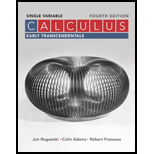
To prove:
The formula for all natural number using the principle of induction.
Explanation of Solution
Given info.
If the statement is true for and
When a statement is true for a natural number then it will also be true for its successor .
Then statement will be true for all natural number n. this is called principle of mathematical induction.
Proof:
Show that is true
Left hand side
R.H.S.
Thus, the statement is true for
Now, follow induction step.
If is true for then it will also be true for
Let us assume that is true condition that means
Then by taking above statement true, proceed and prove that its successor will also be true.
L.H.S.
As we know that
Substitute the value
Take as common factor
This is the value of R.H.S.
Now, we have full-filled both conditions of the principle of mathematical induction. The formula is therefore true for every natural number.
Want to see more full solutions like this?
Chapter C Solutions
Loose-Leaf Version for Calculus: Early Transcendentals Single Variable
- Please focus on ix.arrow_forwardPlease focus on vi.arrow_forward的 v If A is an n x n matrix that is not invertible, then A. rank(A) = n C. det(A) = 0 B. Reduced row-echelon form of A = In D. AB BA= In for some matrix B 63°F Partly sunny Q Search 3 $ 4 40 FS 96 S W E A S T FG S Y & コ B ㅁ F G H J 4 Z X C V B N M 9 H V FIB - FIB ㅁ P L ว DELETE BACHSPACE LOCK L ? PAUSE ALT CTRL ENTER 7 2:20 PM 4/14/2025 HOME J INSERT SHIFT END 5arrow_forward
- i Compute the given determinant by cofactor expansions. At each step, choose a row or columnthat involves the least amount of computation.7 6 8 40 0 0 68 7 9 30 4 0 5arrow_forwardi Compute the inverse of the matrix below using row operations. Please show your work.1 0 −2−3 1 42 −3 4 This is a 3*3 matrix. First row is 1 0 -2.arrow_forwardSolve the system of equations below by applying row operations on the corresponding aug-mented matrix to convert it to the reduced row-echelon form. Write the solutions using freevariables as parameters.x1 + 3x2 + x3 = 1−4x1 − 9x2 + 2x3 = −1−3x2 − 6x3 = −3arrow_forward
 Calculus: Early TranscendentalsCalculusISBN:9781285741550Author:James StewartPublisher:Cengage Learning
Calculus: Early TranscendentalsCalculusISBN:9781285741550Author:James StewartPublisher:Cengage Learning Thomas' Calculus (14th Edition)CalculusISBN:9780134438986Author:Joel R. Hass, Christopher E. Heil, Maurice D. WeirPublisher:PEARSON
Thomas' Calculus (14th Edition)CalculusISBN:9780134438986Author:Joel R. Hass, Christopher E. Heil, Maurice D. WeirPublisher:PEARSON Calculus: Early Transcendentals (3rd Edition)CalculusISBN:9780134763644Author:William L. Briggs, Lyle Cochran, Bernard Gillett, Eric SchulzPublisher:PEARSON
Calculus: Early Transcendentals (3rd Edition)CalculusISBN:9780134763644Author:William L. Briggs, Lyle Cochran, Bernard Gillett, Eric SchulzPublisher:PEARSON Calculus: Early TranscendentalsCalculusISBN:9781319050740Author:Jon Rogawski, Colin Adams, Robert FranzosaPublisher:W. H. Freeman
Calculus: Early TranscendentalsCalculusISBN:9781319050740Author:Jon Rogawski, Colin Adams, Robert FranzosaPublisher:W. H. Freeman
 Calculus: Early Transcendental FunctionsCalculusISBN:9781337552516Author:Ron Larson, Bruce H. EdwardsPublisher:Cengage Learning
Calculus: Early Transcendental FunctionsCalculusISBN:9781337552516Author:Ron Larson, Bruce H. EdwardsPublisher:Cengage Learning





